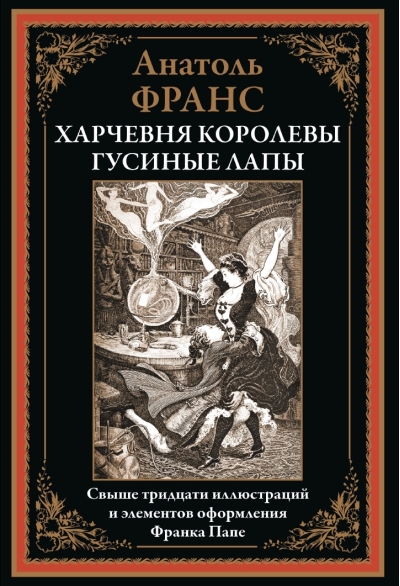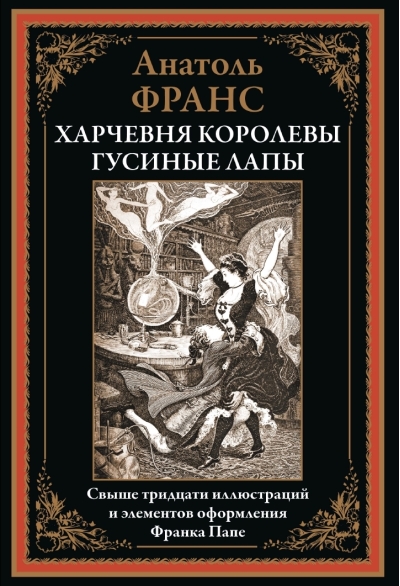Queen Goosefeet Tavern
9.99 €
The only thing available 1
The satirical novel "Queen Goosefoot's Inn" was first published in 1892. Its author - the world-famous writer, Nobel laureate in literature Anatole France (1844-1924) - appears to readers as a refined philosopher, sharply criticizing the surrounding reality and watching the moral decline of people, whom he nevertheless accepts with all their weaknesses and vices. The text is published in translation by Nadezhda Mikhailovna Zharkova. The book is decorated with elegant drawings by the English artist and book illustrator Frank Cheyne Pape (1878-1972).
Anatole France's satirical novel "Queen Goosefoot's Tavern" was first published in 1892, two years after the publication of his novel "Tais". Frans was yet to become a member of the French Academy, to write his famous novels "The Gods are thirsty" and "Rise of the Angels" and receive the Nobel Prize for Literature in 1921. Love for books, reading and literature originated in Frans in childhood, because the father of the future writer was the owner of a bookstore. No wonder that in his youth Anatole became one of the participants of the Parnassian school - a circle of young writers and poets who rallied around Theophile Gautier. In the late 70-ies of the XIX century Anatole France became a leading literary critic of the newspaper "Le Temps". However, seriously engaged in literary work, he was able only after receiving the post of deputy director of the library of the French Senate. The first fame Frans brought a novel, published by him in 1881 - "The Crime of Sylvester Bonnard. It was a witty satire on sanctimonious virtue, which passes before frivolity and kindness. Approximately in the same ironic way was written and the novel "Queen Goose Lapa's Tavern". In this work, as well as in many subsequent ones, France demonstrates his great erudition and the ability to subtly understand human psychology. The main character of this work - Abbot Jerome Quagnard - tries to lead a pious life, but falls into sin and justifies his "fall" that it strengthens his humility. The book is decorated with drawings by the English artist Frank Cheyne Pape. They are distinguished by a special sophistication and refinement. The future illustrator was born in London in 1878 in the family of a financier. Artistic education Frank received in the School of Fine Arts, which was opened in the middle of XIX century in London philanthropist Felix Slade. Within its walls Pape learned to master gouache, watercolor, pen and ink. Already in the early twentieth century, his drawings began to be published by various publishers. Frank successfully performed illustrations for editions of Homer, Suetonius, Rabelais, Spenser, Sabatini, Defoe and other famous writers. However, it was the drawings for the works of Anatole France, including his novels "Tais", "Rise of the Angels", "Penguin Island" and "Queen Goosefoot's Inn" that brought him the greatest fame. Frank Pape lived a long life, having passed his ninth decade. Toward the end of his career, he illustrated the tales of "One Thousand and One Nights" and another reprint of "Robinson Crusoe".
Anatole France's satirical novel "Queen Goosefoot's Tavern" was first published in 1892, two years after the publication of his novel "Tais". Frans was yet to become a member of the French Academy, to write his famous novels "The Gods are thirsty" and "Rise of the Angels" and receive the Nobel Prize for Literature in 1921. Love for books, reading and literature originated in Frans in childhood, because the father of the future writer was the owner of a bookstore. No wonder that in his youth Anatole became one of the participants of the Parnassian school - a circle of young writers and poets who rallied around Theophile Gautier. In the late 70-ies of the XIX century Anatole France became a leading literary critic of the newspaper "Le Temps". However, seriously engaged in literary work, he was able only after receiving the post of deputy director of the library of the French Senate. The first fame Frans brought a novel, published by him in 1881 - "The Crime of Sylvester Bonnard. It was a witty satire on sanctimonious virtue, which passes before frivolity and kindness. Approximately in the same ironic way was written and the novel "Queen Goose Lapa's Tavern". In this work, as well as in many subsequent ones, France demonstrates his great erudition and the ability to subtly understand human psychology. The main character of this work - Abbot Jerome Quagnard - tries to lead a pious life, but falls into sin and justifies his "fall" that it strengthens his humility. The book is decorated with drawings by the English artist Frank Cheyne Pape. They are distinguished by a special sophistication and refinement. The future illustrator was born in London in 1878 in the family of a financier. Artistic education Frank received in the School of Fine Arts, which was opened in the middle of XIX century in London philanthropist Felix Slade. Within its walls Pape learned to master gouache, watercolor, pen and ink. Already in the early twentieth century, his drawings began to be published by various publishers. Frank successfully performed illustrations for editions of Homer, Suetonius, Rabelais, Spenser, Sabatini, Defoe and other famous writers. However, it was the drawings for the works of Anatole France, including his novels "Tais", "Rise of the Angels", "Penguin Island" and "Queen Goosefoot's Inn" that brought him the greatest fame. Frank Pape lived a long life, having passed his ninth decade. Toward the end of his career, he illustrated the tales of "One Thousand and One Nights" and another reprint of "Robinson Crusoe".
See also:
- All books by the publisher
- All books by the author
- All books in the series Library of World Literature





















